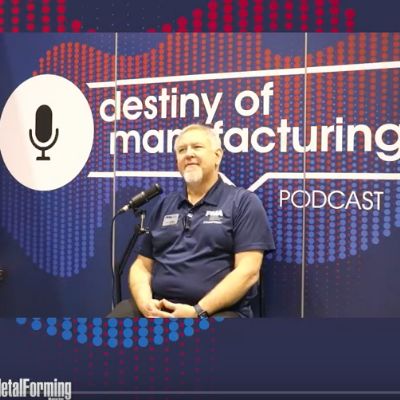Frontline-Leadership Training Reenergizes CI
Leathers and his management team decided that in order to move RFC’s CI efforts off the plateau and up to the next level, it would have to invest in focused training of its frontline leaders. These are the folks charged with directing the company’s dozens of CI teams.
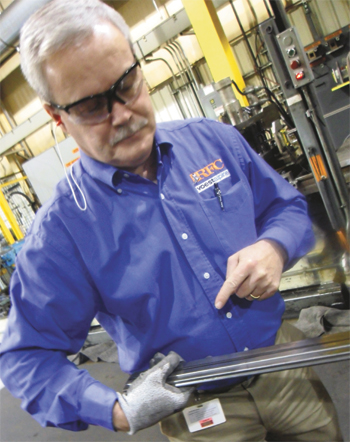 |
| Production supervisor Bruce McIntosh, shown here describing a rollformed part fabricated on an RFC production line, credits conflict-management training at the firm’s Leadership Academy as helping keep the two CI teams he oversees focused on meeting their objectives. |
“In 2006, we sought out to identify the key characteristics that RFC leaders should have,” says Leathers. Efforts centered on developing the skills required to effectively lead teams—specifically CI teams. Then, to teach those leadership skills, RFC launched its Leadership Academy, built upon a series of eight courses designed to develop those key characteristics.
Since 2006, more than 140 RFC associates have enrolled and completed the Leadership Academy. The paid training occurs in eight monthly 4-hr. sessions. Graduates include several rolling-machine operators who have taken on the role of team coordinators. In doing so, they earn an hourly pay increase.
Included in the Leadership Academy curriculum:
- The Oz leadership principle, which stresses individual and organizational accountability
- Improving interpersonal and assertive communications
- Tools to control attitudes
- Dynamics of motivating groups
- Conflict management
- Skills for improved coaching.
RFC Leadership Academy graduates typically point to conflict-management training as a highlight. But Leathers credits the firm’s culture of personal accountability, taught using the Oz principle, as truly allowing the CI program to flourish.
“When you have a strong gain-sharing program, the best policemen you have are right there out on the shop floor,” Leathers says. “And when we started running our employees through the Leadership Academy, we learned that as we provided guidance and leadership to the CI process, the effectiveness of our CI initiatives jumped noticeably.”
Of course, when you invite ideas from so many sources, conflicts are sure to arise. Hence the attention to conflict management in the Leadership Academy.
“If you ask about the lessons learned as we’ve strived to continuously improve our CI program,” says plant manager Tony Carriss, “that’s the big one. Successful CI teams work to obtain input from everyone on the team, and work through disagreements among team members so we get team-wide buy-in on how to move forward.”
Production supervisor Bruce McIntosh credits training in conflict management with helping him keep the two CI teams he oversees focused on meeting their objectives. “Leadership Academy courses taught me how to properly conduct myself on the floor and in meetings,” he says, “and how to handle conflicts between the frontline workers when they arise. I’m a better listener, and a better coach. I encourage the team to stay on task, but it’s up to them to get it done. And they understand that.”
CI Ideas Born on the Shop Floor
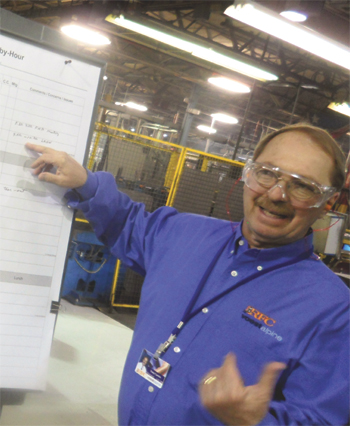 |
| Plant manager Tony Carriss notes that what the operators add to their hour-by-hour charts often turn into CI team projects, “so our employees know we’re listening to their concerns and actively addressing issues on the floor.” |
“Every RFC employee sits on at least one CI team, and while maybe 10 percent of their time they’re actively engaged on a CI project,” says Leathers, “we expect that they’re thinking about CI 100 percent of the time.”
An overwhelming percentage of CI team projects emanate from the workers out on the shop floor, creating a bottom-up management philosophy markedly different than the top-down management style once in place at the company. So says Carriss, a 28-yr. RFC veteran. Of note is the operators’ diligent use of hour-by-hour (HBH) charts to track their work flow, note any hiccups and cite any hurdles preventing them from meeting production goals.
Carriss oversees one of the firm’s three Shelbyville plants, which employs 60 on the floor over two shifts, 35 of which are frontline operators. “What the operators note on the HBH charts often turn into CI team projects,” says Carriss, “so our employees know we’re listening to their concerns and actively addressing issues on the floor.”
When CI projects generate additional revenue for the company, or result in savings, RFC’s operators can make a direct correlation between their HBH charts, the CI projects they create and the size of their quarterly STEPS bonus. Many such projects deal with increasing rollforming-line speed and minimizing downtime resulting from maintenance issues or changeovers. Carriss cites several examples where CI projects have resulted in increased line speed by as much as 80 to 100 percent, by addressing issues such as machine lubrication and end-of-line parts handling.
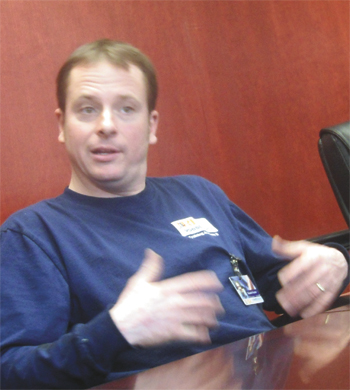 |
| Asked to note one of the bigger CI projects from his CI team, roll operator and team coordinator Ronnie Poynter describes a scarfing process installed inline on one of his roll lines to peel off weld beads. Reengineering the process now directs scrap neatly into a hopper, saving the company more than $1500/yr. in maintenance costs while also enhancing operator safety. |
|
Meet Pem Cornell—
from Farmhand to Master Roll Operator
Master roll operator Pem Cornell’s nearly 29-yr. journey at RFC has propelled him from the fields of Bullitt County, KY, to a critical role overseeing the company’s newly minted lean-manufacturing cell. While Cornell is quick to praise RFC’s continuous-improvement (CI) initiatives and accomplishments, he says that “continuous-improvement projects generally result in incremental gains; our journey into lean will be a big jump forward.” Adds company president Ray Leathers: “Roll lines historically don’t run more than about 30 percent of the time. With lean, we’re hoping to increase operational efficiency to as high as 60 percent.”
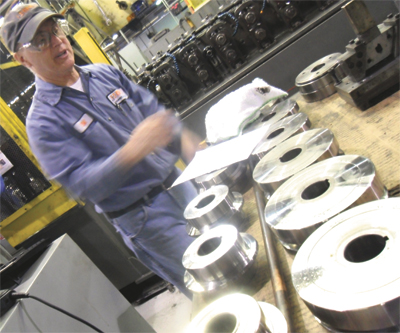 |
| “After working on the lean cell for three or four months, I’ve learned techniques that have dramatically increased machine uptime,” says RFC master roll operator Pem Cornell. “Now I see a lot of my coworkers coming around to get a look at what I’m doing…I am enjoying teaching them and explaining why lean is better, and they’re buying into it.” |
Late in 2011, RFC management asked Cornell to help lead the company’s lean journey, by working with him to build a model lean production line that the rest of the company could emulate. And he’s well into that journey.
“After working on the lean cell for three or four months, I’ve learned techniques—such as prestaging tooling and managing my material needs—that have dramatically increased machine uptime,” Cornell says. “Now I see a lot of my coworkers coming around to get a look at what I’m doing. If they were skeptical at first, they’re not now. I’m enjoying teaching them and explaining why lean is better, and they’re buying into it.”
Cornell clearly enjoys leading RFC’s crew of frontline workers on their CI journey, and in particular enjoys encouraging others to become personally accountable—a mantra of company president Ray Leathers. Asked to explain what being personally accountable means to him, Cornell asks rhetorically:
“Who’s in charge of quality at my production line? I am. That’s what we believe. The operators here don’t rely on the quality department or on management. We take it upon ourselves to ensure our lines operate safely and efficiently, and produce nothing but quality parts. If we need help doing that, we go find the help that’s needed.”
Cornell explains that almost immediately after he was hired as an entry-level roll operator trainee, he would work hard to hone his craft. And when the company instituted its pay-for-skills program in the 1990s, he set his sights on rising to the highest level available—master operator. Yes, by its nature the program rewards skills development with incremental pay increases (15 to 20 percent increases for each of the five levels attained). But Cornell quickly points out that his desire to reach master level was driven by much more than just money.
“I believe strongly that I work for, not at, Roll Forming Corp., and that’s a significant difference. I care about this company, and feel that if they (management) invest in me by offering me training and incentives to increase my skills, then I owe it to them to find s to make the company more money.” |
Process Ownership Builds a Sense of Pride
Roll operator and team coordinator Ronnie Poynter acknowledges the jump in CI-team effectiveness as a result of his participation in the Leadership Academy. Hired in 1995 almost right out of high school as a trainee roll operator, Poynter has progressed to step four—certified roll operator—in the five-step process (trainee, apprentice, qualified, certified and master) to becoming a master roll operator. And, he’s close to climbing that final step up the ladder.
Poynter works at RFC’s plant three, housing nine rollforming lines manufacturing products primarily for the office-furniture industry. He recalls that when management first introduced the CI program to employees some 10 yr. ago, “we were all curious to understand how it would impact us on the floor. But once we learned that it’s our ideas driving it and we really own the processes, continuous improvement became engrained in the company’s culture.”
Asked to note some of the bigger CI projects from his team, Poynter describes a scarfing process installed inline on one of his roll lines to peel off weld beads. The process created large amounts of spiral slugs that landed randomly all over the floor. “This created a huge maintenance and cleanup issue—time consuming and unsafe,” Poynter recalls. Reengineering the process—with the help of RFC engineer Keith Woods and a modest investment to upgrade the scarfing unit—now directs the offal neatly into a hopper on one side of the machine. The company is saving more than $1500/yr. in maintenance costs, and operator safety has been greatly enhanced. Further, Poynter passed the process improvement over to another RFC plant where the scarfing offal is even more problematic, because waste material is thicker and heavier.
McIntosh, who oversees two CI teams in plant three, shares successes from a team responsible for robotic welding. As part volumes generally have dropped for the plant, and setups per shift have increased, the team needed to focus on reducing setup time. “The frontline operators worked with our toolroom and maintenance department to develop a fixturing solution that is saving us $3000/yr.,” McIntosh says. “While this might not seem significant, the team does this regularly. Management expects each CI team to develop at least one project per quarter; this particular team probably executes two or three projects each quarter.”
Prioritizing the Project Portfolio
CI facilitator Patty Sweasy—also the firm’s safety and training facilitator—paints for us the big CI picture at RFC. “We’re yielding anywhere from $350,000 to $500,000 in savings every quarter from our CI projects,” she says. Each CI project is documented by the teams and any savings resulting from the project are reported to Sweasy.
“Come the new year, we ask the CI teams to use one CI meeting to focus only on ideas that will immediately result in cost savings,” Sweasy says. Teams brainstorm ideas and those ideas the team deems worthy of completion are added to the team project list. Then they are prioritized for completion. Ideas might be as simple as using a little less grease on a machine, but companywide they add up.
“The first time we conducted this exercise, in January 2009, we documented more than $700,000 in savings,” says Sweasy, “and we’ve repeated the exercise each year since. Savings realized in 2010 exceeded $1.5 million, and in 2011 savings exceeded $1.7 million.”
Particularly rewarding to Sweasy is watching the CI teams flourish under the direction of leaders equipped with the skills learned in the Leadership Academy, and through team-building exercises. She’s quick to express appreciation to Leathers and other RFC managers who encouraged her to grow beyond her original job in customer service, which she started in 1996. Likewise, she pays forward that encouragement to RFC’s rank and file, nudging them to move outside their comfort zones and take advantage of the numerous training opportunities available.
Sweasy adds that in 2011, RFC conducted 2807 employee training sessions (number of sessions multiplied by the number of attendees), accounting for 6935 employee training hours amongst four of the company’s five plants. (A fifth plant was acquired in 2009, and did not come under her wing until this year.) Her annual training budget averages $130,000, and it’s rising as the firm adds employees. Seventy-five percent of that total is for budgeted and planned training, with the remaining dollars allocated to discretionary training such as Leadership Academy courses. In addition, the firm participates in the Kentucky State Skills Training Grant, which allows companies to recover half of their approved costs for occupational and skills upgrade training through the reimbursement of training funds.
“We’ve received that state grant for the last 5 yr.,” says Sweasy, “to the tune of more than $150,000.” MF
See also: voestalpine Roll Forming Corporation
Technologies: Training
 Prior to the recession of 2000-2001, Roll Forming Corporation (RFC) was a $35 million company. Today it’s a still-growing $115 million company that’s added—following the dip-and-recovery growth line followed by most U.S. manufacturing companies—110 jobs since mid-2010 throughout its five plants in three states, three in Shelbyville, KY, and one each in Indiana and Pennsylvania. As many of its new hires were displaced workers, RFC’s been busy teaching its new employees new skills. And, perhaps more importantly, it’s been engraining in them the company’s culture of personal accountability and continuous improvement. Long-term success has come thanks to pay-for-skills initiatives, career growth for employees, and a continuous-improvement culture braced with a substantive gain-sharing program.
Prior to the recession of 2000-2001, Roll Forming Corporation (RFC) was a $35 million company. Today it’s a still-growing $115 million company that’s added—following the dip-and-recovery growth line followed by most U.S. manufacturing companies—110 jobs since mid-2010 throughout its five plants in three states, three in Shelbyville, KY, and one each in Indiana and Pennsylvania. As many of its new hires were displaced workers, RFC’s been busy teaching its new employees new skills. And, perhaps more importantly, it’s been engraining in them the company’s culture of personal accountability and continuous improvement. Long-term success has come thanks to pay-for-skills initiatives, career growth for employees, and a continuous-improvement culture braced with a substantive gain-sharing program.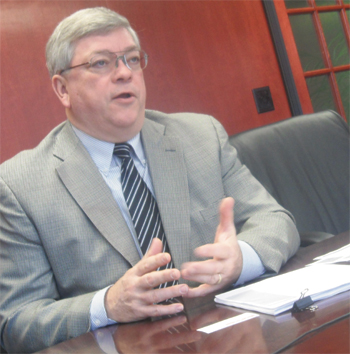







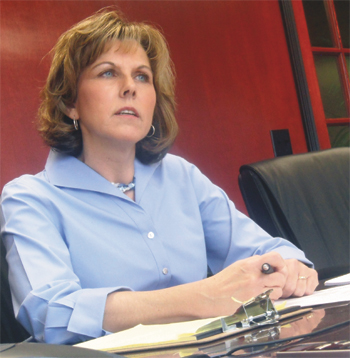




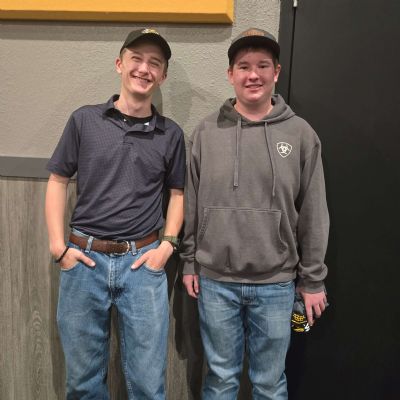

 Podcast
Podcast